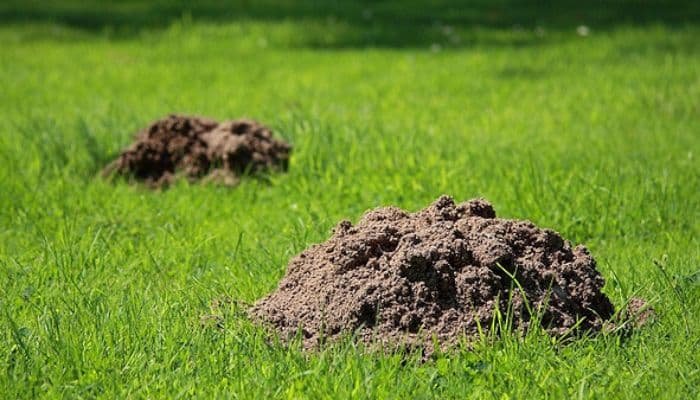Your Guide to Northwest Arkansas Mole Control

Moles are small mammals that, while they do not pose a threat to humans or animals, can cause significant damage to lawns and gardens.
Mounds of dirt pushed up from their underground tunnels can destroy the aesthetic beauty of green spaces and plants, as well as lead to erosion issues over time.
Furthermore, moles consume many insects which would otherwise be beneficial for soil health. Therefore, in order to protect both gardens and ecosystems it is important to understand how best to control mole populations if necessary.
There are several methods available when considering ways to manage moles – physical barriers such as fences or traps; chemical repellents; biological predators like owls or other carnivores; natural paths like utilizing parasitic nematodes – each with its own potential drawbacks and costs attached.
These must then be balanced against ethical considerations such as the need for humane trapping techniques so the animal does not suffer unnecessarily before releasing it elsewhere.
In this article, we will discuss what exactly constitutes a mole infestation problem, review different types of moles by way of exploring identification characteristics, weigh various control options depending on safety levels versus cost-effectiveness vs effectiveness itself , explore preventative measures one could take prior/in lieu of control action being taken against them and closeout.
Understanding Moles
Description of mole behavior and habitat
Moles are burrowing rodents that primarily feed on earthworms and other soil-dwelling insects. They dig extensive underground tunnel systems , which are often found with several entrance and exit holes.
Moles prefer damp or slightly wet, loose soils for their tunnels which usually consist of numerous winding galleries separated by chambers used to store food or rest in between feeding sessions. Moles have an extremely powerful sense of smell enabling them to locate prey in the dark environment they inhabit while also helping them avoid predators.
Identification of different types of moles and their characteristics
Moles are small burrowing mammals that can be identified by their long snouts, scaly tails, and black fur. Actually, there are two main types of moles: the Eastern mole which is found throughout North America and Townsend’s mole which is mainly located in western regions.
Both species of moles have large front claws used for digging complex networked systems of tunnels up to several hundred feet long just to search for their food such as grubs, earthworms, spiders, and plant roots.
Moles persevere even in cold temperatures using thick pelts with extra insulation fur to stay warm while they navigate underground pathways.
Discussion of the potential damage caused by moles
Moles can cause literally significant damage to lawns and gardens by visibly uprooting plants, eating plant roots, and tunneling through the soil as this is their way to looking for food.
These tunnels can disrupt the natural aeration of your soil which prevents water from properly draining in wet climates or prevents moisture from reaching dry soils. Because moles feed on grubs that destroy grass root systems, the destruction left behind by their burrowing is often amplified as a result of their presence- you can easily spot them!
Methods of Mole Control
1. Physical methods of mole control (e.g. trapping, fencing).
Physical methods of mole control are typically the first things that come into our minds in attempting to get rid of moles.
Trapping is one physical method and includes setting traps strategically around tunnels or other areas where activity has been observed, which catches the mole alive when it passes through- although it is challenging, it is definetly one of the most effective methods.
Fencing can also be used as a form of exclusion with various materials that run several inches below ground to block tunneling access from entering yards, landscapes , or gardens, hence catching the moles.
2. Chemical methods of mole control ( e.g. repellents, toxic baits)
Chemical methods of mole control are considered to be the most effective and cost-efficient form of mole management compared to other methods.
These include using surface repellents, aerosols, or granular formulations that can irritate a mole’s sensitive respiratory system, causing them to stay away from treated areas . Additionally, toxic baits can also be used; however, these can only be handled by professionals due to their potentially hazardous contents- it is crucial to be always safe.
3. Biological methods of mole control (e.g. predators, pathogens)
Biological methods of mole control involve releasing or encouraging predators, such as snakes and owls, to feed on moles–taking advantage of the lifecycle .
Certain species of nematodes can also be applied directly to the soil in order to disrupt a mole’s burrowing habits by causing irritation in their tissues. Additionally, certain microbial pathogens can be deployed that infect and kill subterranean-dwelling vertebrates through ingestion. This method is both safe and cost effective while being somewhat more gentle than physical or chemical measures. However, it must be done with caution as some predators may end up killing non-target wildlife animals.
Prevention and Maintenance
Tips for preventing mole infestations
To prevent mole infestations , homeowners should undoubtedly take preventive measures such as mowing tall grass and trimming low-lying plants that actually provide a comfortable habitat for moles. Levels of moisture in soil should also be reduced through proper drainage techniques to make habitats less desirable for the moles- making it ugly for them to live there in the first place is the way to go.
Finally, plants like daffodils, castor beans, or marigolds might act as natural repellents to keep moles at bay; planting them around areas where obvious activity is being done may help deter their presence.
Strategies for maintaining a mole-free property
Maintaining a mole-free property indeed requires regular inspections and maintenance . Landowners should identify any potential mole habitats or access points, including tunnels in damaged soil, insect activity around the area, or den openings that suggest recent burrowing. Inspections can be done annually to confirm no new moles have entered the property.
For properties near large bodies of water like ponds or rivers, more frequent monitoring is also highly suggested as extending moisture can invite foraging moles on adjacent tracts. Lastly, landowners are encouraged to learn about their local wildlife laws when trapping and removing moles from an infested property so as not to violate regulations set by state departments of natural resources.
Importance of regular inspections and maintenance
Regular inspections and maintenance of property are essential for the prevention and control of moles. This includes regularly inspecting yards, gardens, lawns, trees or wooded areas in order to detect signs of mole activity while they’re still small and can be managed before an infestation occurs or worsens.
Furthermore, any implemented form of mole control should also be maintained on a regular basis (weekly – monthly) as new tunnels that may develop could indicate continuing presence. Additionally, certain exclusion techniques such as barriers or fences around gardens need to remain intact in order for them to work properly without fail.
Ethical Considerations
1. Discussion of the ethical implications of mole control
Mole control comes with a variety of ethical considerations . Traps and poisons can cause pain and distress to the moles, therefore there should be guidelines in place for the humane use of these methods. Alternatives such as repellents, fencing or predators are considered more ethical as they do not put a strain on the animal’s welfare.
Additionally, trapping and removal may need to be considered ethically since killing moles is often used as the only means of population reduction despite it being expensive and potentially dangerous due to their large burrow networks underground. Trappers must also take into consideration how relocating animals will affect local balances in order to protect other species from becoming endangered because of the displacement of ecosystems after relocation efforts occur.
2. Importance of considering non-lethal methods of control
When it comes to mole control, considering non-lethal methods should be of utmost importance. Lethal or physical means of controlling moles include trapping and fencing , which can often result in unnecessary suffering for the animals.
Alternatives such as repellents, biological controls (such as using predators), and cultural practices are more humane options that need to be given serious consideration before choosing a course of action. Releasing trapped moles into nearby areas without broad damage potential is also an ethical option for those seeking to remove these pesky pests from their property.
3. Discussion of humane trapping and release options
Humane trapping and release is an ethical approach to mole control. This method can involve using traps that are specifically designed not to harm the animals caught inside, as well as releasing them in a suitable area away from any populated areas.
It should also be noted that this type of trapping requires regular maintenance, such as emptying the traps or replenishing bait and water sources. Furthermore, it’s important for those utilizing these methods of removal to act with respect towards wildlife and take precautions against causing unnecessary animal suffering without sacrificing safety concerns of homeowners.
In a Nutshell
In conclusion, moles can pose a threat to plants and property. There are several options available for controlling these pests, each of which has different effectiveness, cost, and safety issues.
It’s also essential to learn about mole behavior and inspect your property regularly so that potential infestations can be identified quickly and dealt with before damage occurs .
In line with this it’s recommended implementation prevention strategies like cleaning up possible food sources around your home grounds boundary lines where moles could gain access from other neighboring properties/locations) , removing any unsuitable hiding places (i.,e made earth piles),and having good stormwater management systems installed on site should help form preventive measure against unnecessary risk towards moles entering into premises).
Ultimately, knowing how they behave helps inform decisions related to safely removing them while still being cognizant of our moral obligation.
Need pest control? Get in touch!



